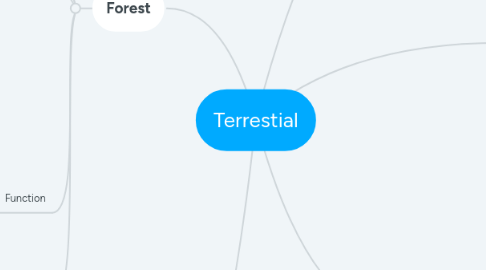
1. Mangrove
1.1. Prevent seedling establishment and build sediments needed for growth
1.1.1. Halophytes and grow at trophic and subtropics area on the equator
1.2. Characteristics
1.2.1. Inundation with tides
1.2.2. Increasing salinity towards ocean
1.2.3. Sandy clay soil
1.2.4. Nutrient poor
1.2.5. Nitrogen & Phosphorus are limiting
1.3. Importance
1.3.1. Shelter for fish
1.3.2. Breeding ground
1.3.3. Prevent wave erosion on the seashore
2. Forest
2.1. A complex relation between physical and biological system
2.2. Provide biodiversity for living things in the forest
2.3. Types
2.3.1. Creating interaction of independence among the biodiversity
2.3.2. Tropical Evergreen Forest
2.3.2.1. Also known as rainforest
2.3.2.2. Dense and received more than 200cm annual rainfall
2.3.3. Temperate Deciduous Forest
2.3.3.1. Also known as Monsoon forest
2.3.3.2. Less dense and received between 70-200 cm annual rainfall
2.3.4. Taiga
2.3.4.1. Also known Boreal forest
2.3.4.2. Animal and plants adapted to the short grooming season
2.3.5. Mangrove Forest
2.4. Function
2.4.1. Watershed protection
2.4.2. Soil and wind erosion control
2.4.3. Atmospheric regulation to supply oxygen
2.4.4. Regulate the temperature around the world
2.5. Maintaining the supply of drinking water
3. Mountain
3.1. Land that are higher than 400 m
3.2. Easily effected by climate
3.3. Benefits
3.3.1. Source of fresh water
3.3.2. Biodiversity center
3.3.3. For tourism purpose
3.4. Hot Desert
4. Dessert
4.1. Little rainfall
4.2. Type
4.2.1. Cold Desert
4.3. Plant
4.3.1. Little water needed
4.3.2. Stem are thick
4.3.3. Wide roots
4.4. Animal
4.4.1. Can tolerate hot weather
4.4.2. Active at night
5. Grassland
5.1. Regions that have enough average of precipitation for the grass to grow
5.2. Types
5.2.1. Tropical
5.2.1.1. High temperature
5.2.1.2. Prolonged dry season
5.2.2. Tundra
5.2.2.1. Very cold
5.2.2.2. Low biodiversity
5.2.3. Temperate
5.2.3.1. Many plain hills
5.2.3.2. Bitterly cold winter
